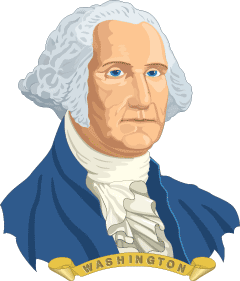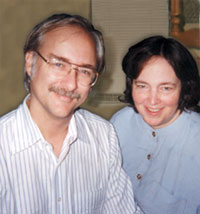How George Washington Learned the Art of War
By Rob Shearer
Printed in Practical Homeschooling #23, 1998.
 George Washington was a soldier before he became Commander-in-Chief. How did he learn how to fight... and win?
George Washington was a soldier before he became Commander-in-Chief. How did he learn how to fight... and win?

|
 |
 George Washington is one of the most important figures in American History. Almost all historians would agree with that assessment. It is therefore more than a little curious to read most textbook accounts of the period from 1700-1800 and discover how little is apparently known about his life. In most textbooks, he springs full-blown upon the scene only when he is chosen by the Continental Congress to command the military forces of the rebellious colonies in June of 1775. Washington was then 43 years old. But apart from chopping down a cherry tree and hurling a silver dollar across the Potomac River, most texts tell us very little about his activities prior to the Revolution. Fortunately, Washington left us a detailed record of his youth . . . and it makes a fascinating story.
George Washington is one of the most important figures in American History. Almost all historians would agree with that assessment. It is therefore more than a little curious to read most textbook accounts of the period from 1700-1800 and discover how little is apparently known about his life. In most textbooks, he springs full-blown upon the scene only when he is chosen by the Continental Congress to command the military forces of the rebellious colonies in June of 1775. Washington was then 43 years old. But apart from chopping down a cherry tree and hurling a silver dollar across the Potomac River, most texts tell us very little about his activities prior to the Revolution. Fortunately, Washington left us a detailed record of his youth . . . and it makes a fascinating story.
George Washington was his father's third son, by his second wife. The family plantation in Tidewater, Virginia, was promised to his oldest brother. Washington, like almost all younger sons, would have to make his own way in the world, adopt a career and struggle to establish his own wealth rather than content himself with administering an inherited family estate.
At sixteen, the young George Washington became enamored of the wealthiest family in colonial Virginia, the Fairfaxes. Thomas, Lord Fairfax was the largest land-owner in Virginia. He was the only English peer ever to take up residence on his lands in the new world. In 1748, Lord Fairfax wished to confirm portions of his lands lying west of the Blue Ridge mountains and so commissioned a survey to mark off the boundaries. He asked his 24-year-old great-nephew, George Fairfax, to accompany the surveying party. George Fairfax, in turn, invited the 16-year-old younger son of the neighboring Washington family to accompany the surveying party on their trek through the wilderness. The two Georges became fast friends. For the next four years, until just after his 20th birthday, Washington continued his association with the Fairfaxes, repeatedly making trips across the mountains to survey their land, and along the way purchasing some large but inexpensive tracts of land in the frontier region of Virginia for himself.
Then, in 1752, young George shifted his attentions from surveying to a military career. In July, his elder brother Lawrence died, and his estate passed to his widow. Though he did not inherit his brother's land, there was something of Lawrence's that George wanted. Lawrence had been the adjutant of the Colonial militia, and George began a campaign to secure that office for himself. Though he was only 20, he had good connections through the Fairfaxes. The colonial governor took the opportunity of a vacancy to split the office into three, with each adjutant responsible for the militia in a portion of the colony. Late in the year, George Washington was pleased to learn that he had been appointed adjutant for the Southern district, along the fringe of the colony, south of the James River. Washington was given a commission of major in the colonial militia along with the post of adjutant and a salary of 100 pounds per year.
One year later, in the summer of 1753, word reached the settlers in Virginia that the French had moved south from their trading posts along the Great Lakes and had begun building a series of forts to secure the head-waters of the Ohio River valley. The Virginia colonists were alarmed, and the governor resolved to send a warning to the French and an ultimatum demanding that they surrender their forts in the Ohio Valley or be driven from them by force.
Washington hurried to Williamsburg and volunteered to undertake the mission to deliver the ultimatum to the French. He had turned 21 just a few months before. But Washington was the only one of the three adjutants who had experience traveling in the wilderness beyond the Blue Ridge mountains. Three weeks later, George Washington reached the French fort just above the forks of the Ohio and delivered the ultimatum. The French, though polite and hospitable to the 21-year-old major, were adamant. Washington later reported, "They told me it was their absolute design to take possession of the Ohio, and by God they would do it!"
Washington returned with this defiant answer. The colonial governor promptly promoted Washington from Major to Lt. Colonel and sent him back to drive out the French. He had orders to erect a permanent post at the strategic forks of the Ohio (the site of modern-day Pittsburgh). Serving under Washington in "the Virginia Regiment" were six captains (two of them Scots who had fought with Bonnie Prince Charlie in 1745), all of whom were older and more experienced than their 22-year-old Lt. Colonel. Washington's militia were joined by several companies of regular Crown soldiers from Maryland and North Carolina. He quickly discovered that even officers of lower rank who held commissions from the Crown thought themselves superior to the young Lt. Colonel of the colonial militia. Washington resolved that one day he would have a commission in the regular British army.
Washington soon discovered that the French had gotten to the forks of the Ohio first and built their own fort there which they called Fort Duquesne. Washington's troops ambushed a small French reconnaissance party and defeated them and then built their own "Fort Necessity" near the French fort. The main body of French troops from Fort Duquesne soon arrived, besieged the little force of Virginians and forced their surrender. The French graciously allowed the English colonial force to withdraw peaceably, but young Lt. Col. Washington was deeply ashamed. The French were still in command of the forks of the Ohio and his own force had been defeated. For the rest of his life, he would regard the anniversary of this day as an unhappy occasion. The date was July 4, 1754.
That same summer, unexpectedly, his niece died. His brother's widow had re-married and moved to her husband's estate. Thus, George suddenly found himself not only the heir, but able to take immediate possession of the family lands and plantation at Mount Vernon. He resigned his commission in the militia for the life of an aristocratic planter, though he concluded his letter to the governor with the sentence, "My inclinations are strongly bent to arms."
One year later, the British government launched a more ambitious attempt to drive the French out of the Ohio valley. This time, it would not be just the colonial militia, but 1,400 British regulars under the command of Major General Edward Braddock. Washington wrote to Braddock offering his services, and Braddock appointed the 23-year-old to his headquarters staff. Washington resumed his rank of Lt. Colonel in the colonial militia. On July 9, 1755, Braddock's force was ambushed and massacred by a combined force of French soldiers and their Indian allies. Braddock refused to allow his men to break ranks and take cover when they came under fire, though Washington pleaded with him. Braddock denounced the colonial militia as cowards for breaking ranks. When Braddock was mortally wounded and many of the British officers were killed, Washington took charge and led the survivors on a fighting retreat out of the wilderness. Among the survivors was a young backwoodsman, driving a wagon-load of supplies for the British troops, named Daniel Boone. Also among the survivors was a British officer named Thomas Gage, who 18 years later would command the British troops sent to occupy Boston and put down the rebellion in the colony of Massachusetts.
Washington's reputation was not harmed by his involvement in the ill-fated expedition of General Braddock. Upon his return from the wilderness, he was promoted to full Colonel and named commander-in-chief of the Virginia militia. For the next three years he would be stretched to the limit with the frustrating task of trying to protect Virginia settlers in the wilderness from the devastating, lightning-quick, terrorist raids of the Indian allies of the French. There was not much Washington could do, since the Indians could not be engaged in a full-scale battle. They slipped through the wilderness in small bands and avoided pitched battles, targeting isolated farmsteads one after another. It was a time of devastating terror for colonists on the frontier.
Finally, in 1758, the British dispatched a new force, under General Forbes, to launch one of three simultaneous attacks designed to defeat the French in North America. Washington, a full Colonel, though only 25, had five years of military experience and almost 10 years time spent tramping through the Virginia wilderness. Nevertheless, once more, he felt slighted by the British regular officers who dismissed all colonial soldiers as little more than amateurs. Washington worked closely with General Forbes as they advanced through the wilderness towards Fort Duquesne. Once more, though, the advice of the colonial commander was ignored and an advance British party was ambushed and massacred. But Forbes had almost twice as many men as Braddock, and he continued to push through the wilderness. In November of 1758, Forbes and Washington were both surprised to learn that the French had abandoned Fort Duquesne and burned it to the ground. The British forces took possession of the site and built a new fort, which they named Fort Pitt in honor of the British Prime Minister.
The victory seemed somewhat hollow to Colonel Washington. He had hoped for a battle in which he could prove his military skill and win a commission in the British army. In disappointment, he returned home and resigned his commission in the militia once again.
In early 1759, he married Martha Dandridge Custis, a young widow (she was 28, he was 27) with two small children. A month later, he was elected for the first time to the Virginia colonial legislature. He remained active in politics throughout the 1760's, though he was never much of a public speaker.
Sixteen years later, in 1775, Washington was elected by the Virginia legislature as one of their delegates to the Second Continental Congress. He arrived in Philadelphia wearing his buff-and-blue uniform as Colonel of the Virginia militia - a visible symbol that he was willing to place his military experience at the disposal of the Congress.
And that is how the young backwoodsmen and Virginia militia officer acquired the experience that prepared him to lead the armed rebellion against the British crown. In his youth he had longed for a commission in the British army. Now his experience serving alongside British officers and his memory of their snubs would help him to defeat them.
For more information on the life of this remarkable man, I recommend For King and Country: George Washington, the Early Years by Thomas Lewis, and The Bullet-Proof George Washington by David Barton.